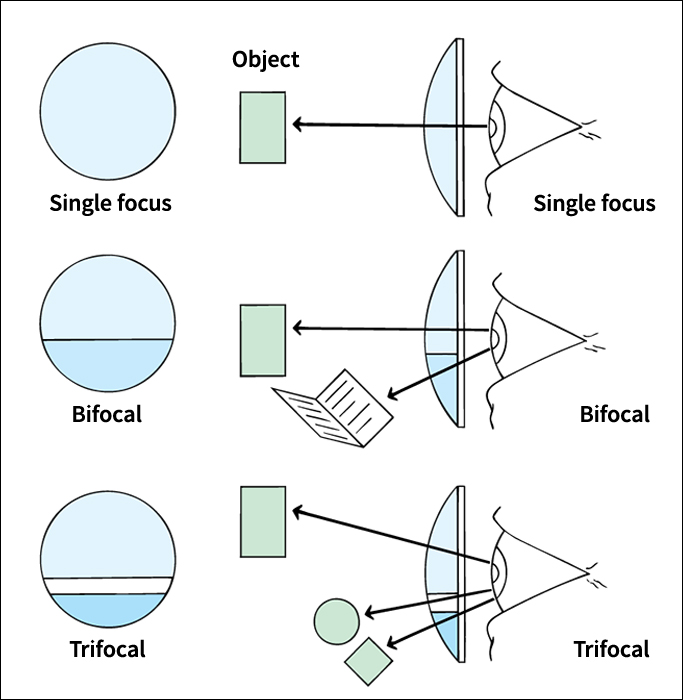Glasses are a pair of lenses held in place in front of the eyes by a frame. People wear glasses primarily to correct faulty vision. Most corrective glasses are prescribed by an eye specialist and are called prescription glasses. In the United States, about 125 million people wear prescription glasses. Millions of others occasionally wear nonprescription glasses, which include sunglasses and safety glasses. Such glasses can be purchased without consulting an eye specialist.
No one knows when or where people first wore glasses. Europeans probably began wearing them in the 1200’s. Marco Polo, an Italian trader and traveler, reported that he saw people wearing glasses in China about 1275. The demand for glasses used for reading increased after printed books started to become available in the late 1400’s. During the 1500’s, people also began using glasses for clearer distance vision. In 1784, the American scientist and statesman Benjamin Franklin invented bifocals. Bifocals have two-part lenses–one part for reading and one for distance vision.
Prescription glasses
help the eye focus light rays correctly. To form a clear image, the eye must focus light rays on the retina, the area at the back of the eyeball. If light rays do not focus on the retina, a blurred image results. Common focusing problems that can be corrected by glasses include nearsightedness, farsightedness, presbyopia, strabismus, and astigmatism.
Nearsightedness, also called myopia, results if the light rays reflected from distant objects focus before they reach the retina. Nearsighted people can see nearby objects clearly, but distant ones are blurred. Concave lenses, which are thinner in the middle than at the edges, correct myopia. See Myopia .
In farsightedness, also known as hyperopia, the light rays reflected from nearby objects reach the retina before focusing. Farsighted people generally can see distant objects clearly, but nearby ones appear blurred. Convex lenses, which are thicker in the middle than at the edges, correct hyperopia. See Farsightedness .
Nearly all people develop presbyopia sometime during their 40’s. This condition results in the loss of the ability to focus on near objects. People with presbyopia require convex lenses for reading and for other close work.
Some children develop strabismus, commonly called cross-eye. In strabismus, the eyes look in different directions. Some cases of strabismus are associated with extreme farsightedness. In such cases, glasses that correct the farsightedness enable the eyes to look in the same direction. Without the help of glasses, the vision in one eye may grow poorer and poorer. See Strabismus .
Astigmatism results when light rays meet in two places within the eye, producing blurred, misshapen images. In most cases, astigmatism occurs because the cornea, the transparent covering at the front of the eye, has an uneven shape. Cylindrical lenses correct astigmatism. See Astigmatism .
Glasses may have single-focus, bifocal, or trifocal lenses. A single-focus lens has one focal point–that is, all light rays that pass through the lens meet at one point. In a bifocal lens, the top of the lens has a different focal point than the bottom. The top part is used for distance vision and the bottom part for near vision. A trifocal lens has a third focal point in the middle of the lens. This part of the lens enables a person to see objects at in-between distances.

How glasses are prescribed and made.
Glasses are prescribed on the basis of an eye examination made by an ophthalmologist or an optometrist. An ophthalmologist is a physician who specializes in treating eye problems. An optometrist examines the eye, diagnoses problems, and prescribes glasses. Optometrists are not physicians.
As light rays enter the eye, they are refracted (bent). During a part of the examination called the refraction, the ophthalmologist or optometrist measures how much more or less each eye needs to refract light rays to focus them on the retina. The patient looks through different lenses, and the examiner then writes a prescription for those that provide the best vision.
The lenses for glasses are made by an optician, a specialist who shapes them according to the prescription. The optician fits the lenses into a frame chosen by the patient and also adjusts the frame to fit the patient properly and comfortably. Lenses are made of glass or plastic. In the United States, the Food and Drug Administration, an agency of the federal government, requires lenses to be impact resistant. Such glasses do not shatter from moderately sharp blows.
Nonprescription glasses
may be purchased without an eye examination and are sold by many stores. Sunglasses have tinted glass or plastic lenses that reduce eye discomfort from sunlight and glare. Dark gray lenses work best, but green and brown lenses are also effective. Many sunglasses contain polarized plastic lenses, which filter out glaring light reflected from flat surfaces (see Polarized light ). Some have special filters that block out ultraviolet rays, which can harm the eyes. Safety glasses are made of extremely strong glass or plastic. They prevent eye injuries from chemicals or from fragments of metal and other materials. Many industries require workers to wear such glasses. People also wear safety glasses while playing such sports as basketball, squash, and tennis. Some people buy nonprescription glasses that have magnifying lenses. These glasses are used for reading.
